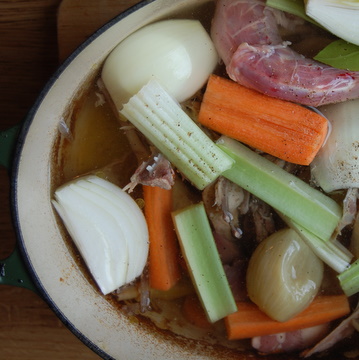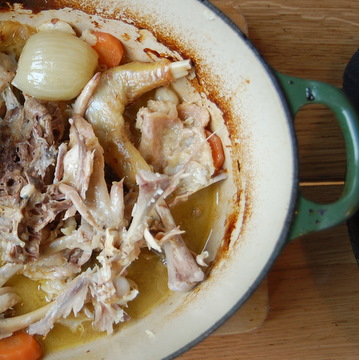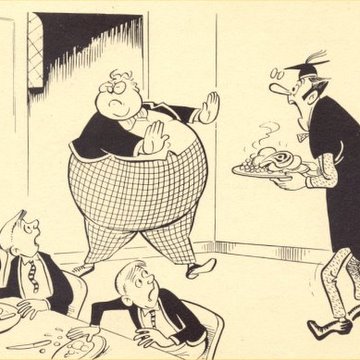|
10th Apr 2008
Mal: I discovered the wonderful powers of chicken stock in the early 1980s when doing some work at the house of the mother of a good friend. Gorgeous Dolly Frankel, as anyone will tell you, always has food cooking or cooling in her kitchen – delicious gefilte fishballs, sumptuous roast chicken and, if you're really lucky, a chicken soup with kneidels. Because she's warm, welcoming and ever-generous, Dolly will feed anyone who enters her home. If they're not hungry when they arrive, they leave with food parcels.
I vividly recall the smell of the soup welcoming me the first time I walked through her kitchen door (I never saw anyone use the front door in Dolly’s house). When suffering a bad cold one week a few months after working at her house, Dolly had some soup and stock delivered to me with instructions to take both, and get well. It worked. She gave Jane some extra-strong, recuperative stock-cum-broth after Maudie's birth which completely did the trick.
She taught me that you don’t need to waste a single bit of a roast chicken, that it is all good (and her daughter, Jennifer, taught me where the chicken ‘oyster’ is to be found). So I started making stock with my roast chicken carcasses every week or so. The following ‘recipe’ I fudged partly from Dolly, and partly from experience of making stock. (And yes, the smell pervades the house, but it’s such a fabulous smell.)
Jane: the deliciousness of the aroma of boiling bones that filters through the house is matter of taste (I count my blessings it's not fish bones bubbling - that only happens about once a year). Still, I love Mal's stock which we always have stacked in the freezer. I use it on a thrice-weekly basis for soups, risottos, in spag bog or simply mixed with honey to baste oven-cooked chicken thighs. It's such a flavour intensifier - everything just tastes better. 22nd Feb 2008
Mal: Until I was five, my name was Jimmy. Then I started school and everyone called me Mal. My brother, who until then I’d always called Freddy, was four years above me at the same school where everyone called him Calvin. Our school names were the ones written on our birth certificates but our grandmother, who lived with us and ruled the home as only a Victorian matriarch could, decided that I looked like a Jimmy and my brother a Freddy. Even our parents called us Jimmy and Freddy.
After reading a feature in 'The New Yorker' about nicknames, I recalled some old school friends whose actual names I can no longer remember: Skinny, Dog-Ears, Daz and Sailor. Comics that I read as a boy were full of nicknames that in turn gave rise to nicknames for real boys – most of them cruel. Plug from the Bash Street Kids being directed at small boys with sticking-out ears was not funny to the boy – although being fat and called Bunter seems much friendlier than some of the current slurs regularly used against larger kids. We have nicknames for Maudie (Mud, Pawdie, Mush) and Edie (McCreedy, Short Stuff, Chuckka), but oddly they don’t have nicknames for any teachers, nor their friends.
Watching ‘Ashes To Ashes’, the 1980s-based sequel to ‘Life On Mars', I realised that nicknames are conspicuous by their absence among the rozzers (except for the Gene Jeanie, which only he uses to address himself), though in those days any tough, male-dominated community always had a Smudger, a Lofty or a Basher. Paul Simonon in The Clash gave new drummer Nick Headon the nickname of Topper because he thought he looked like Mickey the Monkey on the cover of the weekly comic Topper, and it’s stuck with Nick for 30 years. The tradition of giving nicknames, either for endearing purposes or for disarming authority figures, seems to have been lost. I think we should encourage kids everywhere to come up with nicknames for family, friends and their favourite (or otherwise) teachers. All submissions gladly welcomed… 6th Dec 2007
Mal: Now that it’s December the Christmas records (yes, that’s the vinyl) and CDs can be dusted off and come out to play. We have a ban on Christmas music the rest of the year – if anyone so much as starts humming ‘Jingle Bells’ from January to November we jump on them – but come early December, the Christmas-themed tunes are played full blast until the end of the year.
I’m kind of proud that they’re both fans of Phil Spector’s unique treatment of the Xmas song. For most of the 1970s and 1980s his album ‘A Christmas Gift To You’ was the only holiday-themed record deemed listenable by hip music fans (and that of course included me). It’s packed with his crazy wall-of-sound backing for traditional songs such as ‘Parade of Wooden Soldiers’ and ‘Silent Night’, as well as classic pop songs like ‘Winter Wonderland’ and ‘White Christmas’, making them sound as epic and contemporary today as when he recorded them in 1963. A great Christmas song needs to be full of either emotion or mad humour. Spike Jones and his City Slickers’ version of ‘Rudolph The Red-Nosed Reindeer’ is the epitome of the wacky fun-filled Xmas song. Likewise Huey ‘Piano’ Smith’s version of ‘Twas The Night Before Xmas’: with its rolling New Orleans piano and deep bass voice, it sounds like the musical accompaniment to a classic Tom & Jerry cartoon. ‘Twas the night before Christmas…’ is the first line of the most famous Christmas poem ever written (in 1823 by Clement Clark Moore), and the inspiration for the first Christmas pop song (1963) to give Santa his route down the chimney. Since then, ‘Up On The House Top’ has been covered by scores of singers, most recently and successfully by Kimberley Locke in 2005, though I prefer the Jackson 5 version from 1970.
In fact, because of my age perhaps, there are a lot of Christmas song recordings from the 1970s that I love. Not the usual Slade and Wizard megahits of the day, but Mud’s ‘Lonely This Christmas’ which is a slight reworking of the Elvis version of ‘Blue Christmas’, and the Partridge Family’s ‘My Christmas Card To You’ being particular favourites. The latter was the only original number on the David Cassidy and Shirley Jones-led TV family’s Christmas album of the same name, a vinyl copy of which – now 36 years old – is still played in our house during December.
As a twentysomething, I used to bug the hell out of the left-leaning, self-styled rebels I shared a house with by loudly playing the CBS Frank Sinatra album, recorded in his 20s and full of carols. ‘The Sinatra Christmas Album’ (the later Capitol recordings) still sounds pretty good too. These days there are so many fantastic Christmas song compilations covering every musical genre that you can make a different compilation every year (which I do) and not repeat anything. Only Edie and Maudie demand ‘I Saw Mommy Kissing Santa Claus’ and ‘Marshmallow World’ on every single one. It’s ruining my street cred, but what’s a dad to do?
Here are some other songs that rock our Christmas socks. Please send us your Xmas favourites, we’d love to hear them… Mal: Barbra Streisand's 'A Christmas Album' and my friend Pete Silverton’s 2004 Christmas compilation CD, full of fantastic and unusual songs (we can send you a tracklist, just ask…). 13th Jul 2007
Wandering around the annual French fair on our local green, Maudie spied a stall selling dolls which looked like 1920s’ flappers, made out of beads and feathers. As she looked them over, I spotted a thin bookcase beside the stall and searched through it. Two matching gold volumes with the words, ‘The Golden Encyclopaedia For Children’ embossed on the spine were irresistible. Pulling them out, the raised galleon ship on their front covers was so beautiful that I thought, ‘I’d pay £5 each for them’, even before I’d looked inside. Both volumes had clearly been well cared for — and I only had to pay £1.50 for both.
The frontispiece of Volume I, a hand-coloured image of HRH Princess Elizabeth of York aged about six or seven, made me think that the books were published in the 1930s. The introduction by Sir Malcolm Campbell, ‘The World-famous Racing Motorist’ proved it — he was the father of Donald Campbell and broke the world land and water speed records in the 1920s and 30s in his self-designed Bluebird cars. In the introduction Campbell writes of the encyclopaedia, ‘I confess it has fascinated me, for never do I open its pages without finding some piece of knowledge that either I have never possessed at all or have, in the passage of time, forgotten.’ That evening, quizzing the grown-ups (most of whom have highly respectable college degrees) on the questions set out in the back of each volume, it was clear everyone shared Sir Malcolm’s experience.
The books are full of fantastic detail about the natural world and social wonders — the growth of traffic, air travel and house building. The colour illustrations are beautiful, the photographs, such as a full-page image of an Italian organ grinder with his monkey, are black and white documentary facts that reveal much about the world of the 1930s.
Glancing through this encyclopaedia one has to wonder how anyone can ever think that electronic or digital media will replace the book. Will anyone in a 70 years’ time be able to walk across a green space in sunshine and discover for sale this or any other blog?
Maudie and I returned to the French fair the next day with Edie. Maudie was determined to buy one of the flapper dolls and wanted Edie to see them. Amazingly almost all of the dolls had gone, but the stall owner rooted through some boxes and as the girls waited expectantly I went back to the bookcase and searched the bottom shelves. I have no idea why, but I pulled out a small hardback with a split spine titled ‘Wild Wales’ by George Borrow (for info on him go to wikipedia).
Opening it to look at the imprint page, I noticed a series of blue ink stamps on the endpapers. It had been a library book and the dates, crudely crossed out with ink, began in Feb 1945, which was interesting in itself. However the stamp on the opposite page was of more interest. In Gothic lettering it said ‘Lagerbucherei Stalag XVIII’ and above it, ‘This book read by Arb. Kdo. No.’ It had obviously been in a book depository of a German POW camp. Stalag XVIII was a camp in Wolfsburg in Austria, primarily housing survivors from the Greek campaign of 1940-41 (in particular the Battle of Kalamata) and apparently there had been a fair few Welsh soldiers interned there. The book, originally published in 1862, is a 1939 Everyman Library reprint (John Dent & Sons). I was holding a physical, real link to WWII. It was mine for 50p. Maudie’s doll cost £9.50. History is so cheap.
|

|















